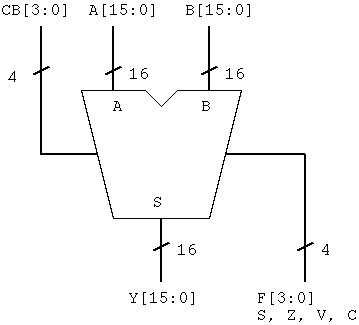

The flag output is a 4-bit bus and there are sign flag "S",
zero flag "Z", overflow flag "V", carry flag "C" in it.
The bit order of FR is FR[3:0] = { S, Z, V, C }.
Let's describe the ALU part in Verilog HDL as "alu.v".
Incidentally, be careful of working in the same directory from the design of ALU to functional simulation. .
module alu (A, B, CB, Y, F) ;
input [15:0] A ;
input [15:0] B ;
input [ 3:0] CB ;
output [15:0] Y ;
output [ 3:0] F ;
reg [16:0] tmp ; // result
reg V ; // for overflow
always @ (A or B or CB)
begin
case (CB)
`IADD : tmp<= { 1'b0, A } + { 1'b0, B }; // Addition
...
...
...
...
...
...
...
...
...
`ILSR : tmp <= { A[0], 1'b0, A[15:1] }; // Logical right shift
...
...
...
...
default : tmp <= { 1'b0, A }; // pass through operand A
endcase
end
assign Y = reassigning result;
always @( A or B or tmp or CB )
case ( CB )
`IADD : V <= ( ( condition ) && ( condition ) ) ? 1 : 0;
`ISUB : V <= ( ( condition ) && ( condition ) ) ? 1 : 0;
`IINC : V <= ( ( condition ) && ( condition ) ) ? 1 : 0;
`IDEC : V <= ( ( condition ) && ( condition ) ) ? 1 : 0;
`IASL : V <= ( A[15] != tmp[15] ) ? 1 : 0;
default : V <= 0;
endcase
assign F[3] = ...... ; // Sign flag
assign F[2] = ...... ; // Zero flag
assign F[1] = V; // Overflow flag
assign F[0] = ...... ; // Carry flag
endmodule
Next, description of flag attempts to have.